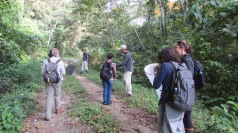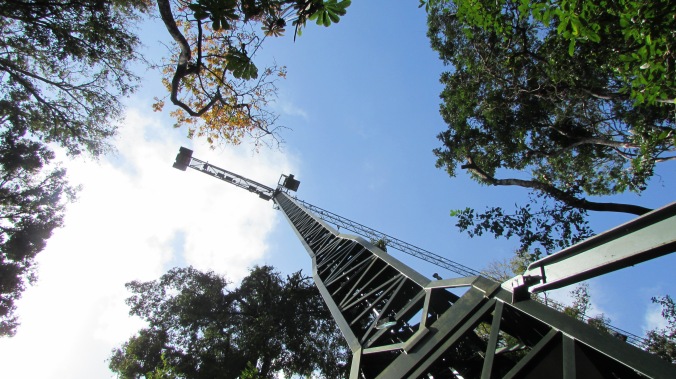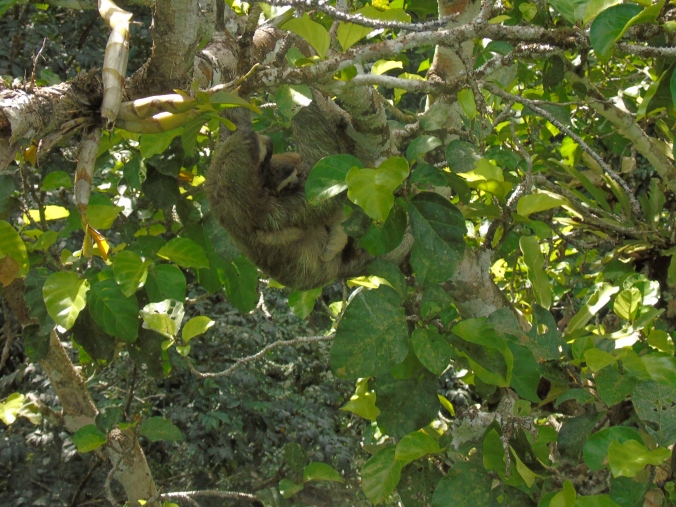A few days ago, we went to visit Fort Sherman, located in the province of Colon, on the Caribbean coast of Panama. The Fort was an important rainforest warfare training site for US soldiers from 1953 until 1999. This site forms part of the Parque Nacional San Lorenzo, created in June 1999, and consisting of 12,000 ha of humid rainforest.

During the walk, we noticed a huge diversity of plants and animals, mainly butterflies, along the trail. The location of the fort is considered as a hybrid zone for studies of speciation. For example, the butterflies that belong to the genus Heliconius are from the tropics, and they show a huge diversity of wings patterns. This genus have been under rapid speciation and divergence, and also show an amazing amount of convergence in wing pattern due to mimicry.
We had the opportunity to catch some species of Heliconious and we were able to observe different behavior traits like the one presented by H. sara where the  males from smaller sizes are very territorial. Furthermore, during the field trip we were able to observe how the butterflies use niche partition and we saw a flying representant of the hyribrid zone Anartia fatima and comimetic individuals like H. melpomene and H. erato.
males from smaller sizes are very territorial. Furthermore, during the field trip we were able to observe how the butterflies use niche partition and we saw a flying representant of the hyribrid zone Anartia fatima and comimetic individuals like H. melpomene and H. erato.

Xylaria fungi
As well, on the trunks, we observed fungi that belong to the Xylaria genus, some of them are known as producers of bioactive compounds. Commonly, this genus is found growing over dead wood.
Finally, we arrived at the San Lorenzo Canopy Crane, which is around 52 m high and 54 m long. The crane is used in several studies, such as structure and dynamics of the upper canopy, biodiversity of different organisms, and biotic interactions, like pollination and herbivory. The experience of being on the top of the crane was amazing, the landscape formed by the different kinds of trees mixed with the view of the Chagres river was one of the best things during the trip.
One of the most charismatic megafauna that we had the encountered was a three-toed sloth. The individual that we had the opportunity to see was a female (Bradypus variegatus) with her baby, as you can see in the picture. This animals are characteristic for being lethargic, and for spending a great part of their time hanging in trees, where they even mate and give birth.Take a look at this very cool project,, done in Barro Colorado, which recorded sleep activity with an electroencephalogram (EGG) attached to the sloth’s head. They discovered that sloths do not sleep that much, only approximately 9.5 hours per day, probably due to the necessity of continuously foraging, and being alert to predators.
It is really wonderful the huge diversity of organism interacting between them in a single place, from the microorganisms to the biggest tree. We hope that ecological protected areas, like Parque Nacional San Lorenzo, remain preserved to many generations will be able enjoy the great experience to be there.
Gracias por leer,
Librada y Flor
External Links:
http://www.stri.si.edu/english/research/facilities/terrestrial/cranes/research_info.php
http://heliconius.zoo.cam.ac.uk


Pingback: Of the Smithsonian Tropical Research Institute (STRI) | Notes de recherche – Research notes
Pingback: De l’Institut de Recherches tropicales Smithsonian (STRI) | Notes de recherche – Research notes
Pingback: Of the Smithsonian Tropical Research Institute (STRI) | STRI's Tropical Biology Field Course 2015